Ultrabeat est un synthétiseur de batterie et lecteur d'échantillon qui est livré avec Logic Express et Logic Pro 9. Il est livré avec son propre séquenceur pas à pas qui vous permet de créer des modèles pour tous et chacun des 25 sons c'est (connu sous le nom des voix). Chaque voix peut être un échantillon ou un son synthétique tordu par vous-même (ou, bien sûr basée sur l'un des nombreux presets inclus).
Une question souvent posée est de savoir comment ajouter un effet plug-in à une seule voix .... Par exemple, vous pouvez ajouter de la réverbération au piège et y ajouter un compresseur seulement pour le Kick ou ajouter un peu de retard exclusivement au salut-chapeaux. Bien sûr, une fois que vous faites glisser le motif dans Logic zone Arrangement, tous les sons sont sur une piste assignée à une bande de canal = un ensemble d'effets pour cette voie. Dans cette astuce, nous allons nous concentrer rapide sur la façon d'ajouter un traitement d'une voix individuelle d'Ultrabeat Logic intérieur.
ATTENTION: Une fois que vous savez comment faire, votre patterns de batterie ne sera jamais le même ...
Etape 1 - Insérer une instance de sortie multi-
Créez une piste Software nouvel instrument. Maintenant nous avons besoin d'insérer une instance de sortie du multi-Ultrabeat sur elle. Cela vous permettra de voix route de Ultrabeat à leurs propres sorties séparées.
Cliquez et maintenez sur la fente supérieure d'E / S et dans le menu choisissez Ultrabeat
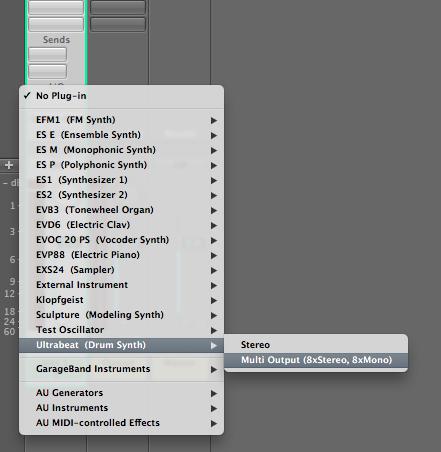
Dans Ultrabeat, choisissez n'importe quel preset et le modèle de choix. Je vais utiliser le préréglage par défaut et Motif.
Etape 2 - Affectation Sorties
Afin d'ajouter des effets différents pour les différentes voix, ces voix doivent être sur leur propre canal de bande. En réalité, le signal de notre voix choisie sera acheminé à séparer les bandes de canaux auxiliaires.
Pour définir cette place nous devons nous concentrer sur la zone d'Ultrabeat Voix affectation (à gauche). Ici vous pouvez mute, solo, modifier les niveaux et le panoramique et la voie toute voix à lui est propre sortie. Vous remarquerez que chaque voix est actuellement fixé à la sortie principale (ou la bande de canaux d'instruments logiciels).
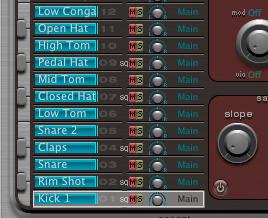
Je vais assigner Kick 1, rim shot, Claps, Closed Hat et Hat Pédale (qui contiennent tous des séquences) pour séparer les canaux auxiliaires afin que nous puissions les traiter séparément.
Cliquez sur le mot principal (zone de sortie) pour une voix et de le menu déroulant assigner votre voix choisie (s) à leur propre production.
Notez que vous avez 8 stéréo (incluant la sortie principale) et 8 sorties mono.
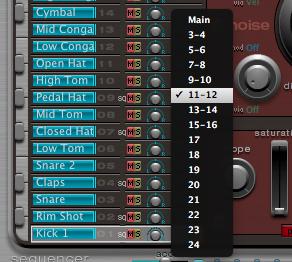
Étape 3 - Création canaux auxiliaires
Logique Open Mixer (vous pouvez fermer la fenêtre Ultrabeat interface graphique si vous le souhaitez ou appuyez sur V sur votre clavier pour basculer masquer / afficher toutes les fenêtres de plug-in).
Maintenant, nous avons besoin de créer des canaux auxiliaire pour chaque son d'être acheminé vers. Vous pouvez créer des canaux auxiliaires dans un certain nombre de façons ... mais, la méthode suivante permettra de créer des canaux avec la configuration Aux correcte de routage de Ultrabeat.
Cliquez sur le bouton sur le bas de la bande de canaux d'Ultrabeat. Cela va créer un canal Aux avec l'entrée de mise à la sortie que vous avez créé dans Ultrabeat. Faites cela pour autant de canaux auxiliaire tel que requis.
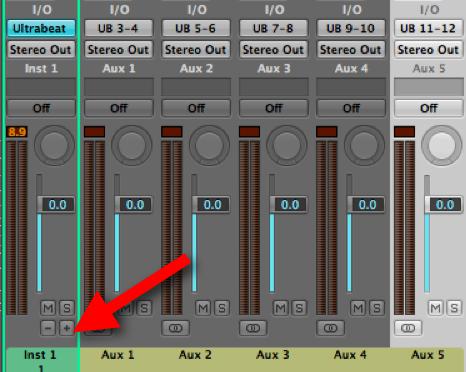
Excellent! Vous avez maintenant acheminés vos sons choisis / voix d'Ultrabeat aux différents canaux auxiliaires qui en fera une brise de traiter chaque canal auxiliaire avec des effets différents,
Final Thoughts
Vous pourriez, comme à la lecture de votre profil Ultrabeat à ce stade et commencer à insérer des effets sur les canaux auxiliaires différents. C'est une bonne idée de nom à chaque canal auxiliaire en double-cliquant sur le nom. Par ailleurs, pour chaque canal auxiliaire, vous pouvez ajuster les niveaux, la balance, solo, mute, la voie à des sorties supplémentaires, ajouter des effets étranges et merveilleux ... le monde est maintenant votre huître Ultrabeat!
Si vous avez besoin d' aider à ce sujet ou toute autre logique ou un problème logiciel Mac nous rendre visite à www.macprovideo.com/forum/
Interested in learning more about Ultrabeat and unleashing the drummer inside? These tutorials will help you to become proficient whether you are starting out or looking for advanced tips, tricks and techniques! We'd love to hear from you. Let us know what you think by writing a comment below!


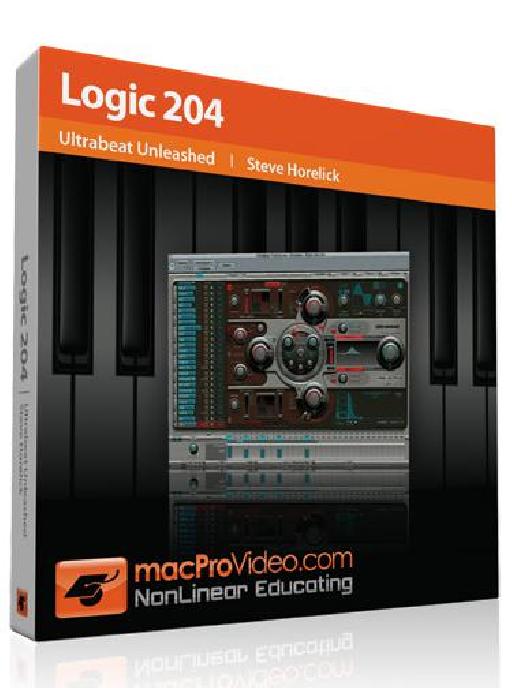
 © 2024 Ask.Audio
A NonLinear Educating Company
© 2024 Ask.Audio
A NonLinear Educating Company
Discussion
Thanks!
Glad you found it useful :)
I've got Logic Express 9.0 on my MacBook Pro. It's going ok, but I'm a bit stuck on one thing. I think it must be something really simple but I can't find the answer on the net anywhere.
I have made patterns in ultrabeat then dragged them to the arrange window. I would like to then re open that same pattern in ultrabeat and change it slightly still using the same kit and on the same channel. After editing or creating other tracks, when I re open ultrabeat on say the Latino kit that I used, my pattern that I created doesn't come up in ultrbeat. When I play the pattern, I can see the blue keys on the side lighting up and I can see the beats in the piano roll. How can I see these in ultrabeat where the blue lights keep flashing?
Thanks
Once you've dragged a pattern from Ultrabeat to Logic's Arrange area you can't edit it in Ultrabeat's Step Sequencer. It's a shame... if Ultrabeat supported 'MIDI region import', I'd be so happy!! But as it is, once the region is in the Arrange the best you can do is edit it in the Piano Roll or the Hyper Editor (which once understood is a very powerful drum editor indeed!) Have you checked out Steve H's Ultrabeat Unleashed tutorial? It's the definitive place to go to learn about Ultrabeat IMHO.
Pop by the macprovideo forums also if you need any more help.
Best
Rounik
Thanks again,
Dom
Well, you can edit it in Ultrabeat's Step Sequencer - but think of Ultrabeat as a separate plugin outside of Logic's MIDI Editors. Once you bring it into the Arrange area then it's out of Ultrabeat's hands...
Still I completely agree, being able to import MIDI regions into Ultrabeat seems like a no-brainer. Hopefully that'll happen in a future Logic update or version!
:)
Not too familiar with Garritan Aria Player. How do you have each sound from it routed in Logic? are there 8 stereo outputs from Aria begin routed to their own Aux channels for example?
If so, then you can adjust the balance/pan on those Aux channels in the Mixer.
basically my problem is that I don't hear my other loaded instruments in my Aria player, the plugin instrument. How and where do I select the instrument that I want to record in? I only hear my first loaded instrument that is in the first slot in the instance, channel 1.
Have you inserted the Aria player on a normal Software Instrument track? This could be the problem.
Try creating a new Software Instrument track from Track > New...
This time, make sure the "Multi-timbral" option is checked.
Choose Number: 8 (for 8 stereo sounds from the Aria).
Now you'll find that 8 tracks are created in the Arrange. Each one with it's own MIDI Channels (1-8). However, they all use the same Instrument (Aria) but selecting 2nd track will playback the "2" sound from Aria, etc.
Hope this helps
Rounik
1. (as in this tutorial with Ultrabat) you need to assign the sounds / channels within Aria to an output - and then create Aux channels and use those to control and mix the different elements from the Aria player.
2. There is a method Steve H show cased in his Logic TNT2 tutorial... that uses the Environment - Once you set it up it's very cool... It's videos 18-25 in this tutorial here if you're interested:
http://www.macprovideo.com/tutorial/logic9303tnt2
Hope this helps
Rounik
Want to join the discussion?
Create an account or login to get started!